

10 Strategies to Improve Instructional Leadership. I still vividly remember my early years as an assistant principal and principal.
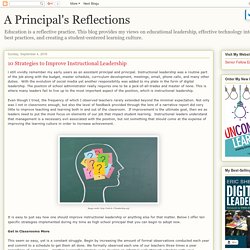
Instructional leadership was a routine part of the job along with the budget, master schedule, curriculum development, meetings, email, phone calls, and many other duties. With the evolution of social media yet another responsibility was added to my plate in the form of digital leadership. The position of school administrator really requires one to be a jack-of-all-trades and master of none. This is where many leaders fail to live up to the most important aspect of the position, which is instructional leadership. Even though I tried, the frequency of which I observed teachers rarely extended beyond the minimal expectation.
Image credit: It is easy to just say how one should improve instructional leadership or anything else for that matter. 9 Ways to Plan Transformational Lessons: Planning the Best Curriculum Unit Ever. When instructors engage learners, develop ability and understanding, and amplify students' identities, we call them "transformational teachers" -- professionals who provide learners with disciplinary View-Masters so that kids can see the world in stereoscope.
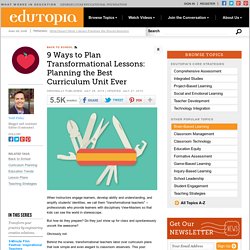
But how do they prepare? Do they just show up for class and spontaneously uncork the awesome? Obviously not. Behind the scenes, transformational teachers labor over curriculum plans that look simple and even elegant to classroom observers. This post explains how they do that, specifically looking at nine transformational practices in planning. 9 Ways to Plan Transformational Lessons: Planning the Best Curriculum Unit Ever. Nine Insights I Learned From National Leadership Forum 2016. Growing Leaders hosted our National Leadership Forum last week.

Every year, I love the opportunity I get to meet leaders from all over the world and watch them connect with each other, as they learn, grow, and prepare for their next academic season. This year, we had perhaps our best experience yet. Our theme was: “Leaders at Every Level.” Conversations—both on and off stage—were about building a culture of leadership in our organizations. I decided to jot down nine of the insights that surfaced over the two-day forum. Culture works like a movie sound track. To teach baseball, we're don't make students memorize the definition of a base. Why do we do that w/ other subjects? - @dtangred #gafesummit.
Fresh Prince: Google Translated. The Top 10 Rules for Talking Like a Leader. The Top 10 Rules for Talking Like a Leader It’s deadly to fall in love with your own voice, but the higher you go, the more you need to talk effectively.
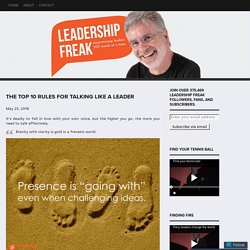
Leadership, Learning and Life. 7 success factors for instructional coaches with Jim Knight. The Truth About Why So Many Leaders Fail, and What Science Says You Need. Phi Delta Kappan. Authors Abstract The author outlines steps for professional development via coaching and emphasizes the role of building and maintaining trust between coach and teacher.

Four guideposts must be followed in coaching: Let the teacher drive the PD; adopt a curious, problem-solving stance; walk the walk; and communicate clearly and transparently. The article is outlined through the author’s experience coaching a struggling teacher. Coaching teachers requires that you develop trust — not just in the abstract but trust that is manifested in shared goals, open communication, and mutual respect. She looked up from the computer screen but didn’t move. I waited a moment. “Well,” I continued, “before we get into the details of coaching, it would help me to get a feel for your classroom.
“OK, when do you want to come?” The coach needs to respect the teacher’s autonomy by offering feedback only on agreed-upon goals. High-quality PD Teacher resistance. Educators Construct Learning. 10 Tips for Delivering Awesome Professional Development. I frequently meet teacher leaders and coaches who ask for tips on giving professional development (PD).
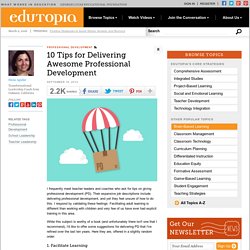
Icg woodruff scale. 10 Characteristics of Professional Learning that Shifts Practice – Katie Martin. Across diverse districts I have asked teachers how they like to learn and what they want out of their professional learning opportunities.
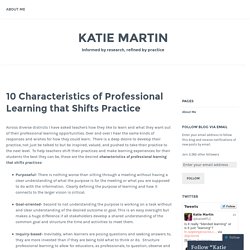
Over and over I hear the same kinds of responses and wishes for how they could learn. There is a deep desire to develop their practice, not just be talked to but be inspired, valued, and pushed to take their practice to the next level. To help teachers shift their practices and make learning experiences for their students the best they can be, these are the desired characteristics of professional learning that shifts practices: Purposeful- There is nothing worse than sitting through a meeting without having a clear understanding of what the purpose is for the meeting or what you are supposed to do with the information. Clearly defining the purpose of learning and how it connects to the larger vision is critical.Goal-oriented- Second to not understanding the purpose is working on a task without and clear understanding of the desired outcome or goal. Download%3Fid 17387&filename seven claims about successful school leadership. Radical Learners - PEERS Goals Radical Learners. Goal setting is an essential part of coaching.
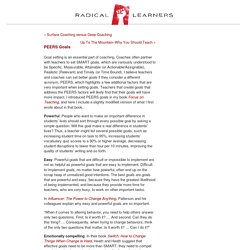
Coaches often partner with teachers to set SMART goals, which are variously understood to be Specific, Measurable, Attainable (or Actionable/Assignable), Realistic (Relevant) and Timely (or Time Bound). I believe teachers and coaches can set better goals if they consider a different acronym, PEERS, which highlights a few additional factors that are very important when setting goals. Teachers that create goals that address the PEERS factors will likely find that their goals will have more impact. I introduced PEERS goals in my book Focus on Teaching, and here I include a slightly modified version of what I first wrote about in that book. Powerful. Easy.